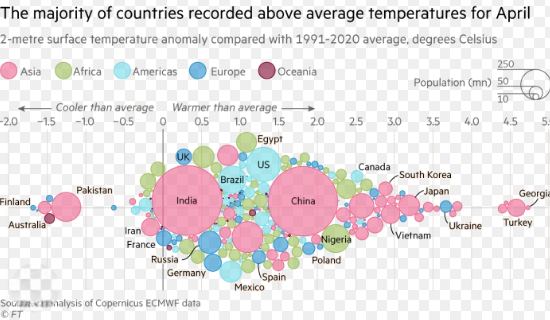Scientists warn that the streak of extreme weather events worldwide is likely to persist due to unprecedented high levels of greenhouse gases. April marked the 11th consecutive month of record-breaking global average surface temperatures, reaching 15.03°C, surpassing the 1991-2020 average for the month by 0.67°C, and exceeding pre-industrial levels by 1.58°C, as reported by the Copernicus Climate Change Service.
Rising temperatures are predicted to intensify extreme weather patterns globally, leading to more frequent occurrences of heatwaves, droughts, and flooding. Currently, large regions across Asia are experiencing scorching heatwaves, with temperatures soaring as high as 48°C in East Asia, while fatal floods ravage areas from southern China to Kenya and Brazil.
Over the past 12 months, the global average temperature has soared to unprecedented levels, standing at 1.61°C above the pre-industrial average. This alarming trend persists despite the Paris Agreement’s aim to limit global temperature increases to ideally 1.5°C, which operates on a longer timeframe.
The record temperatures coincide with the El Niño phenomenon, characterized by elevated sea surface temperatures in the Pacific Ocean. Although the El Niño reached its peak earlier this year, global sea surface temperatures for April remained the highest on record, extending the streak of record temperatures for the 13th consecutive month.
Carlo Buontempo, director of CCCS, highlighted that while temperature fluctuations associated with natural cycles like El Niño are temporary, the accumulation of greenhouse gases continues to drive global temperatures upward. During the 2015-2016 El Niño event, the world experienced 16 consecutive months of record temperatures, with this year’s temperatures surpassing even those levels.
In April, land temperatures soared in various regions, particularly in eastern Europe, northern and northeastern North America, Greenland, eastern Asia, north-west Middle East, parts of South America, and most of Africa. Meanwhile, regions experiencing above-average rainfall include parts of Europe, North America, Central Asia, the Gulf countries, Asia, Australia, and Brazil.
Countries like the United Arab Emirates and Brazil, which recently hosted or are set to host climate summits, are grappling with extreme weather events. The UAE experienced unprecedented flash floods, while Brazil’s southern state of Rio Grande do Sul faced severe flooding, resulting in casualties and displacement of thousands.
Additionally, Kenya and China witnessed devastating floods, causing significant loss of life and displacement. Sir David King, chair of the Climate Crisis Advisory Group, expressed deep concern over the unexpected and alarming trend of record-breaking weather events, underscoring the urgent need for global action to address the climate crisis.















































